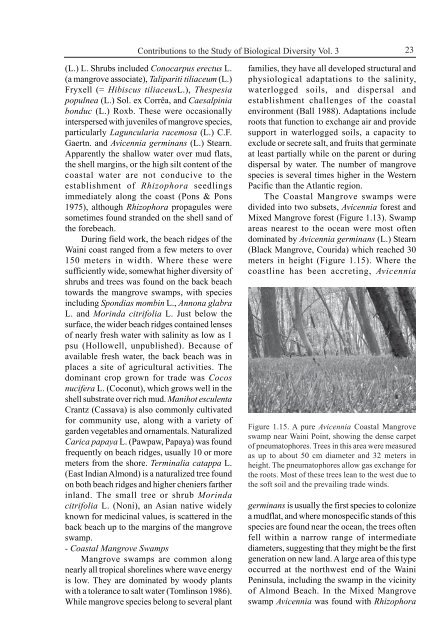Plant Community Structure, Fire Disturbance, and Recovery in ...
Plant Community Structure, Fire Disturbance, and Recovery in ...
Plant Community Structure, Fire Disturbance, and Recovery in ...
Create successful ePaper yourself
Turn your PDF publications into a flip-book with our unique Google optimized e-Paper software.
Contributions to the Study of Biological Diversity Vol. 3<br />
(L.) L. Shrubs <strong>in</strong>cluded Conocarpus erectus L.<br />
(a mangrove associate), Talipariti tiliaceum (L.)<br />
Fryxell (= Hibiscus tiliaceusL.), Thespesia<br />
populnea (L.) Sol. ex Corrêa, <strong>and</strong> Caesalp<strong>in</strong>ia<br />
bonduc (L.) Roxb. These were occasionally<br />
<strong>in</strong>terspersed with juveniles of mangrove species,<br />
particularly Laguncularia racemosa (L.) C.F.<br />
Gaertn. <strong>and</strong> Avicennia germ<strong>in</strong>ans (L.) Stearn.<br />
Apparently the shallow water over mud flats,<br />
the shell marg<strong>in</strong>s, or the high silt content of the<br />
coastal water are not conducive to the<br />
establishment of Rhizophora seedl<strong>in</strong>gs<br />
immediately along the coast (Pons & Pons<br />
1975), although Rhizophora propagules were<br />
sometimes found str<strong>and</strong>ed on the shell s<strong>and</strong> of<br />
the forebeach.<br />
Dur<strong>in</strong>g field work, the beach ridges of the<br />
Wa<strong>in</strong>i coast ranged from a few meters to over<br />
150 meters <strong>in</strong> width. Where these were<br />
sufficiently wide, somewhat higher diversity of<br />
shrubs <strong>and</strong> trees was found on the back beach<br />
towards the mangrove swamps, with species<br />
<strong>in</strong>clud<strong>in</strong>g Spondias momb<strong>in</strong> L., Annona glabra<br />
L. <strong>and</strong> Mor<strong>in</strong>da citrifolia L. Just below the<br />
surface, the wider beach ridges conta<strong>in</strong>ed lenses<br />
of nearly fresh water with sal<strong>in</strong>ity as low as 1<br />
psu (Hollowell, unpublished). Because of<br />
available fresh water, the back beach was <strong>in</strong><br />
places a site of agricultural activities. The<br />
dom<strong>in</strong>ant crop grown for trade was Cocos<br />
nucifera L. (Coconut), which grows well <strong>in</strong> the<br />
shell substrate over rich mud. Manihot esculenta<br />
Crantz (Cassava) is also commonly cultivated<br />
for community use, along with a variety of<br />
garden vegetables <strong>and</strong> ornamentals. Naturalized<br />
Carica papaya L. (Pawpaw, Papaya) was found<br />
frequently on beach ridges, usually 10 or more<br />
meters from the shore. Term<strong>in</strong>alia catappa L.<br />
(East Indian Almond) is a naturalized tree found<br />
on both beach ridges <strong>and</strong> higher cheniers farther<br />
<strong>in</strong>l<strong>and</strong>. The small tree or shrub Mor<strong>in</strong>da<br />
citrifolia L. (Noni), an Asian native widely<br />
known for medic<strong>in</strong>al values, is scattered <strong>in</strong> the<br />
back beach up to the marg<strong>in</strong>s of the mangrove<br />
swamp.<br />
- Coastal Mangrove Swamps<br />
Mangrove swamps are common along<br />
nearly all tropical shorel<strong>in</strong>es where wave energy<br />
is low. They are dom<strong>in</strong>ated by woody plants<br />
with a tolerance to salt water (Toml<strong>in</strong>son 1986).<br />
While mangrove species belong to several plant<br />
23<br />
families, they have all developed structural <strong>and</strong><br />
physiological adaptations to the sal<strong>in</strong>ity,<br />
waterlogged soils, <strong>and</strong> dispersal <strong>and</strong><br />
establishment challenges of the coastal<br />
environment (Ball 1988). Adaptations <strong>in</strong>clude<br />
roots that function to exchange air <strong>and</strong> provide<br />
support <strong>in</strong> waterlogged soils, a capacity to<br />
exclude or secrete salt, <strong>and</strong> fruits that germ<strong>in</strong>ate<br />
at least partially while on the parent or dur<strong>in</strong>g<br />
dispersal by water. The number of mangrove<br />
species is several times higher <strong>in</strong> the Western<br />
Pacific than the Atlantic region.<br />
The Coastal Mangrove swamps were<br />
divided <strong>in</strong>to two subsets, Avicennia forest <strong>and</strong><br />
Mixed Mangrove forest (Figure 1.13). Swamp<br />
areas nearest to the ocean were most often<br />
dom<strong>in</strong>ated by Avicennia germ<strong>in</strong>ans (L.) Stearn<br />
(Black Mangrove, Courida) which reached 30<br />
meters <strong>in</strong> height (Figure 1.15). Where the<br />
coastl<strong>in</strong>e has been accret<strong>in</strong>g, Avicennia<br />
Figure 1.15. A pure Avicennia Coastal Mangrove<br />
swamp near Wa<strong>in</strong>i Po<strong>in</strong>t, show<strong>in</strong>g the dense carpet<br />
of pneumatophores. Trees <strong>in</strong> this area were measured<br />
as up to about 50 cm diameter <strong>and</strong> 32 meters <strong>in</strong><br />
height. The pneumatophores allow gas exchange for<br />
the roots. Most of these trees lean to the west due to<br />
the soft soil <strong>and</strong> the prevail<strong>in</strong>g trade w<strong>in</strong>ds.<br />
germ<strong>in</strong>ans is usually the first species to colonize<br />
a mudflat, <strong>and</strong> where monospecific st<strong>and</strong>s of this<br />
species are found near the ocean, the trees often<br />
fell with<strong>in</strong> a narrow range of <strong>in</strong>termediate<br />
diameters, suggest<strong>in</strong>g that they might be the first<br />
generation on new l<strong>and</strong>. A large area of this type<br />
occurred at the northwest end of the Wa<strong>in</strong>i<br />
Pen<strong>in</strong>sula, <strong>in</strong>clud<strong>in</strong>g the swamp <strong>in</strong> the vic<strong>in</strong>ity<br />
of Almond Beach. In the Mixed Mangrove<br />
swamp Avicennia was found with Rhizophora
















